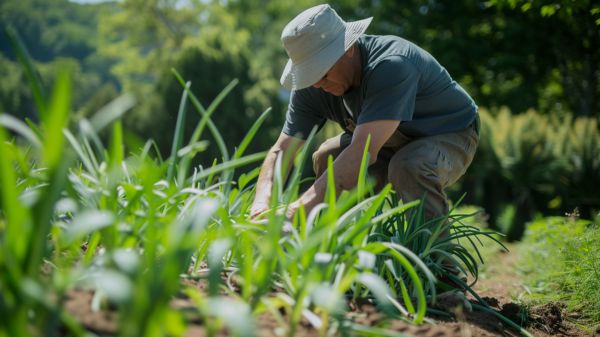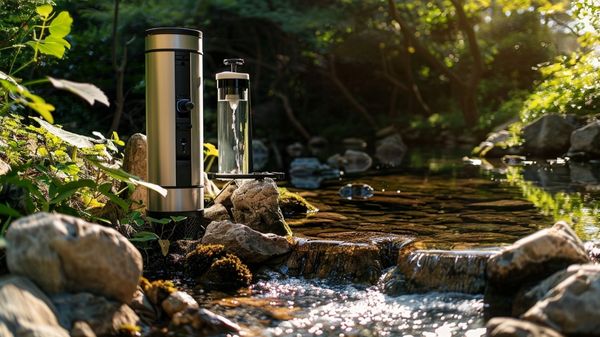As environmental awareness increases, the demand for sustainable practices in everyday activities has never been more important. Gardening, a beloved pastime and a source of home-grown nutrition, is no exception. In today’s post, we’ll be giving and discussing 10 best sustainable vegetable garden planning tips for you.
Sustainable vegetable gardens not only provide fresh produce but also contribute to the ecological balance by conserving resources and promoting biodiversity. However, achieving a truly sustainable garden requires thoughtful planning and strategic implementation.
From soil management to water usage and plant selection, each step carries its own significance. Yet, what are the most effective techniques to guarantee your garden is both productive and environmentally friendly? Let’s explore some foundational tips that are essential for any gardener looking to create a sustainable oasis in their own backyard.
| # | Preview | Product | Rating | Price | |
|---|---|---|---|---|---|
| 1 |

|
Gardening Tools 9-Piece Heavy Duty Garden Hand Tools with Fashion and Durable Garden Tools... |
$35.98 |
Buy on Amazon | |
| 2 |

|
Fiskars Bypass Pruning Shears, 5/8-Inch Cut Capacity Garden Clippers, Gardening Scissors with... |
$13.98
$12.98 |
Buy on Amazon |
Key Takeaways
- Select a sunny, well-draining location close to a water source for your garden.
- Use organic seeds and practice crop rotation to enhance soil health and biodiversity.
- Implement drip irrigation and morning watering to maximize water efficiency.
- Incorporate compost and organic fertilizers to naturally enrich soil nutrients.
- Design garden layouts with raised beds and pathways to optimize space and accessibility.
Selecting the Ideal Location
Choosing the ideal location for your vegetable garden is essential for guaranteeing successful crop growth and ease of maintenance. The selection process involves careful consideration of several key factors including sunlight, soil quality, and accessibility.
Primarily, your chosen location must receive at least 6-8 hours of direct sunlight daily. Sunlight is fundamental for photosynthesis, the process by which plants produce food, especially in fruit-bearing vegetables like tomatoes. A sun-rich spot promotes vigorous growth and maximal yields.
Soil condition is another important aspect. The site should have well-draining soil to avoid waterlogging, which can impede root development and weaken plant health. Heavy or compacted soils should be avoided or amended to enhance texture and nutrient availability.
Implementing organic practices like adding organic matter can greatly improve soil fertility and structure, making it more conducive for vegetable gardening. Assessing the local soil type can also guide the selection of vegetable varieties best suited to the environmental conditions.
Additionally, confirm the garden is easily accessible for regular maintenance and harvesting. Proximity to a water source facilitates efficient irrigation, while a location near your home allows for consistent monitoring and care.
Avoid areas prone to strong winds or overshadowed by large trees and shrubs, as these can greatly reduce light exposure and draw away essential nutrients and moisture from your vegetable garden.
Designing Your Garden Layout
After selecting the ideal location, it becomes imperative to meticulously plan your garden layout to optimize the growing conditions and ease of management.
A strategic garden layout embraces the principle of maximizing sunlight exposure, making sure that the site receives 6-8 hours of direct sunlight daily. This is essential as most vegetables prosper under these conditions, aligning with the goals of sustainable gardening.
Incorporating raised beds, ideally sized at 4×8 or 4×10 feet, enhances soil drainage and quality, facilitating easier weeding and harvesting. The raised design minimizes soil compaction and extends the growing season by warming up the soil faster in spring. It is also a backbone of sustainable gardening as it allows for better water and nutrient management.
Additionally, designing pathways to accommodate wheelbarrows, with main paths at least 4 feet wide, is critical for efficient garden maintenance and access. Including trellises for vining plants not only maximizes vertical space but also improves air circulation and sunlight penetration, important for healthy plant growth.
Integrating aquaponic systems into your garden can also enhance sustainability, creating a symbiotic environment where both plants and fish can thrive. Finally, guarantee adequate spacing between plants, considering their mature size, to prevent overcrowding. This strategic placement minimizes competition and reduces the risk of disease, significant in a sustainable garden layout.
Choosing Sustainable Plants
To cultivate a sustainable vegetable garden, selecting plants that thrive under local conditions is essential. Native plants and herbs, such as basil and mint, are particularly beneficial as they are adapted to local climates and soil, ensuring healthy growth with minimal intervention. In addition, these plants typically require less water and are more resistant to local pests and diseases.
Including a variety of plants like quick-growing leafy greens—kale and spinach—enhances the garden’s productivity and space efficiency. These greens can be harvested multiple times per season, offering continual yields and opportunities for regenerative harvesting. Moreover, integrating disease-resistant varieties of crops like tomatoes and cucumbers helps in reducing the dependency on chemical pesticides, promoting a more organic cultivation method.
Perennial plants also play an important role in sustainability. Plants like asparagus and rhubarb, once established, do not need to be replanted annually. This not only conserves resources but also stabilizes the soil structure, reducing erosion and improving water retention.
Below is a table highlighting sustainable plant choices and their benefits:
| Plant Type | Benefits |
|---|---|
| Native Plants | Less water, minimal maintenance, pest-resistant |
| Leafy Greens | Quick harvests, space-efficient |
| Disease-Resistant Varieties | Reduce chemical use, enhance sustainability |
| Perennials | Long-term harvests, soil stability |
Selecting the right combination of these plants can greatly enhance the sustainability and productivity of your garden.
Soil Preparation Strategies
Effective soil preparation is paramount for a thriving vegetable garden. To achieve this, conducting annual soil tests is vital to ascertain nutrient levels and pH balance. Most vegetables flourish in a pH range of 6.0 to 7.0. These tests guide the appropriate amendments needed to optimize soil health.
Incorporating organic matter, such as compost, is essential. Compost enhances soil structure, increases nutrient availability, and consequently, leads to healthier plant growth and improved yields.
Further enriching the soil with aged manure and balanced organic fertilizers at planting and between crops replenishes essential nutrients and boosts overall soil fertility. These inputs are critical in maintaining the vigor of the soil’s biome, which in turn supports sustainable plant growth.
Additionally, considering the use of sustainable materials can further enhance the environmental friendliness of your gardening practices.
Additionally, practicing crop rotation is a strategic approach to sustaining soil health. By rotating vegetable families annually, it is possible to minimize pest and disease accumulation and prevent nutrient depletion. This method not only preserves the soil’s integrity but also enhances its resilience against biological stresses.
Engaging with local extension services for tailored advice and soil testing can provide specific guidance on improving soil conditions, ensuring that your garden remains productive and sustainable.
Efficient Water Management
Efficient water management is essential for the sustainability of any vegetable garden. Implementing systems like drip irrigation not only guarantees that water is delivered directly to the plant roots, reducing wastage, but also cuts down water usage by up to 60% compared to traditional methods. Such precision in watering liberates the gardener from excessive water use and enhances plant health by maintaining ideal soil moisture levels.
Watering during early morning hours further supports efficient water management. This practice minimizes evaporation losses, allowing approximately 30% more water to reach the roots than watering during peak sunlight hours. Additionally, using mulch around plants can drastically retain soil moisture, diminish evaporation, and stabilize soil temperatures, thereby reducing the frequency and volume of watering needed by 25-50%.
Utilizing rainwater collected in barrels offers an eco-friendly solution, capturing runoff that would otherwise be lost. This practice not only conserves municipal water supplies but also provides liberation from dependence on processed water sources. Regular monitoring of soil moisture with a moisture meter guarantees that plants are neither under-watered nor overwatered, promoting a healthy, sustainable garden environment.
| Strategy | Benefit | Reduction in Water Use |
|---|---|---|
| Drip Irrigation | Targets root, reduces wastage | Up to 60% |
| Early Morning Watering | Minimizes evaporation losses | ~30% more efficient |
| Mulching | Retains soil moisture, stabilizes | 25-50% |
Implementing Organic Practices
Several organic practices can significantly enhance the sustainability and productivity of a vegetable garden.
To begin with, integrating compost made from kitchen scraps and yard waste into the soil not only infuses it with essential nutrients but also improves its structure. This amendment fosters a robust, nutrient-rich environment that supports vigorous plant growth and resilience against disease.
Selecting organic seeds and seedlings is imperative for establishing a garden that is free from synthetic pesticides and fertilizers. This practice guarantees that the plants are non-GMO and have been grown under organic conditions, consequently promoting a healthier and more sustainable ecosystem right from the start.
Additionally, the use of organic matter such as green manures and biofertilizers can further enrich the soil, promoting a more dynamic soil microbiome essential for plant health.
For pest management, adopting natural pest control methods is fundamental. Introducing beneficial insects such as ladybugs, and applying organic solutions like neem oil, offers effective pest control without resorting to harmful chemicals. These methods not only preserve the local fauna but also maintain ecological balance.
Employing techniques like crop rotation and companion planting further enriches soil health and naturally deters pests. These strategies reduce the need for chemical inputs, enhancing both garden health and environmental sustainability.
Encouraging Biodiversity
Building on the foundation of organic practices, another fundamental strategy for enhancing the sustainability of vegetable gardens is to actively promote biodiversity. Incorporating a diverse array of plant species is vital. This variety not only strengthens the resilience of the garden ecosystem but also supports a wide range of beneficial insects and pollinators, like bees and butterflies, which are essential for plant pollination and health.
Utilizing native plants greatly boosts local biodiversity. These plants are well-adapted to the local climate and soil conditions, providing ideal support for native wildlife, including insects that act as natural pest controllers.
Additionally, the practice of companion planting plays a pivotal role. For instance, planting marigolds alongside vegetables can deter pests naturally due to their pungent scent, thereby reducing the need for chemical pesticides. Including plants like Bee Balm and Milkweed can further enhance ecological balance and attract a wider variety of pollinators, contributing to a healthier garden ecosystem.
Moreover, creating specific habitats, such as insect hotels or maintaining undisturbed soil patches, encourages beneficial insects to thrive. These insects, including ladybugs and lacewings, naturally manage pest populations, fostering a balanced, healthy garden environment.
Implementing these strategies not only enriches the biodiversity of the garden but also enhances its productivity and sustainability.
Crop Rotation and Planting
Implementing crop rotation greatly enhances the sustainability of vegetable gardens by mitigating soil nutrient depletion and curtailing the proliferation of pests and diseases.
By practicing a structured rotation over a four-year cycle, gardeners can considerably improve soil health and disrupt the life cycles of common pests that would otherwise thrive on specific crop families.
Succession planting further refines this process by guaranteeing continuous use of space and resources, which can lead to increased yields and extended growing seasons.
For those interested in maximizing garden output, integrating vertical farming techniques can further optimize space and increase productivity, especially in urban settings. For a clearer understanding, consider these key points:
- Diversify Crop Families: Rotate between legumes, nightshades, and brassicas to balance nutrient demands and reduce disease carryover.
- Soil Testing: Regular pH and nutrient analysis help tailor soil amendments precisely, enhancing the growth environment for each crop type.
- Cover Crops: Integrate off-season cover crops like clover to enrich soil organic matter and structure, maintaining an active, healthy soil biome.
- Plan Succession Planting: Strategically schedule crops to immediately follow harvested ones, maximizing garden productivity and efficiency.
- Educate and Empower: Sharing knowledge about these techniques fosters a community of informed, sustainable gardeners aiming for autonomy and ecological responsibility.
These practices not only guarantee a robust garden but also equip gardeners with the tools to claim independence from unsustainable agricultural practices, promoting a healthier planet and community.
Pest and Weed Control
After examining the importance of crop rotation and planting strategies, it is equally important to address pest and weed control to maintain a sustainable vegetable garden.
Implementing organic pest management techniques is vital. For instance, companion planting not only repels pests but also attracts beneficial insects, reducing the need for chemical interventions. This method leverages the natural relationships between plants and insects to foster a balanced ecosystem.
Regular monitoring of the garden is fundamental for early detection of pests and diseases, allowing for timely and effective intervention. This proactive approach helps prevent the spread of infestations and minimizes damage to crops.
Additionally, using mulch can suppress weed growth and help retain soil moisture. This dual function not only reduces competition for nutrients among plants but also contributes to a healthier garden environment.
Hand-picking pests like slugs and caterpillars is another effective, immediate method to control pest populations without negatively impacting beneficial insects or the environment.
Encouraging beneficial insects, such as ladybugs and lacewings, by planting native flowering plants can further enhance natural pest control. These practices collectively promote a sustainable approach to managing pest and weed growth in vegetable gardens.
Harvesting and Storage Techniques
When harvesting vegetables from your garden, it is ideal to do so early in the morning when the temperatures are cooler. This practice not only preserves the freshness of your produce but also enhances its flavor, contributing to a more vibrant and nutritious meal.
Employing precise techniques during harvesting and adhering to effective storage methods guarantees the longevity and health of your plants and produce.
- Use Scissors for Leafy Greens: Cutting rather than pulling helps maintain the integrity of your plants, allowing continued growth and reducing stress to the roots.
- Cool, Dark Storage: Store your produce in environments that delay spoilage. Root vegetables thrive in cool, dark places, extending their freshness.
- Preservation Methods: Embrace canning or freezing to capture the essence of your garden year-round. Freezing vegetables post-blanche secures nutritional value for months.
- Breathable Containers: Opt for containers that allow air circulation to prevent moisture buildup, safeguarding against rot and spoilage.
- Regular Monitoring: Check stored vegetables regularly, removing any that show signs of decay to protect the remaining stock.
These storage techniques empower you to maximize the yield from your garden, guaranteeing a steady supply of fresh, healthy food.
Conclusion
In summary, the establishment of a sustainable vegetable garden necessitates meticulous planning and execution. By strategically selecting a location, designing an effective layout, choosing resilient plant species, and preparing the soil adequately, gardeners can greatly enhance productivity and sustainability.
Integrated practices such as efficient water management, biodiversity enhancement, and systematic pest control further contribute to the garden’s resilience and yield. Ultimately, these practices not only promote environmental sustainability but also guarantee the prolonged success of the vegetable garden.




